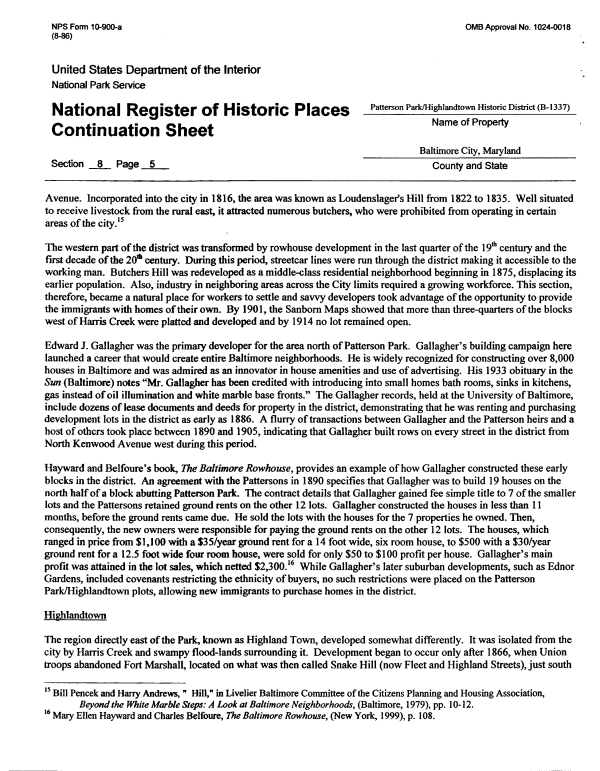 |
||||
|
DEPARTMENT OF HOUSING AND COMMUNITY DEVELOPMENT, MARYLAND HISTORICAL TRUST (Historic Sites Survey) var.d. MSA SE16-3 Image No: se16-3-0100 Enlarge and print image (89K) |
 |
||||
|
DEPARTMENT OF HOUSING AND COMMUNITY DEVELOPMENT, MARYLAND HISTORICAL TRUST (Historic Sites Survey) var.d. MSA SE16-3 Image No: se16-3-0100 Enlarge and print image (89K) |
| NFS Form 1 0-900-a OMB Approval No. 1 024-001 8 (8-86) United States Department of the Interior National Park Service n Historic District (s- National Register of Historic Places f± «. .. *»•_ A Name of Property Continuation Sheet Baltimore City, Maryland Section 8 Page _5_ County and State Avenue. Incorporated into the city in 1816, the area was known as Loudenslager's Hill from 1822 to 1835. Well situated to receive livestock from the rural east, it attracted numerous butchers, who were prohibited from operating in certain areas of the city.15 The western part of the district was transformed by rowhouse development in the last quarter of the 19th century and the first decade of the 20* century. During this period, streetcar lines were run through the district making it accessible to the working man. Butchers Hill was redeveloped as a middle-class residential neighborhood beginning in 1875, displacing its earlier population. Also, industry in neighboring areas across the City limits required a growing workforce. This section, therefore, became a natural place for workers to settle and savvy developers took advantage of the opportunity to provide the immigrants with homes of their own. By 1901, the Sanbom Maps snowed that more than three-quarters of the blocks west of Harris Creek were platted and developed and by 1914 no lot remained open. Edward J. Gallagher was the primary developer for the area north of Patterson Park. Gallagher's building campaign here launched a career that would create entire Baltimore neighborhoods. He is widely recognized for constructing over 8,000 houses in Baltimore and was admired as an innovator in house amenities and use of advertising. His 1933 obituary in the Sun (Baltimore) notes "Mr. Gallagher has been credited with introducing into small homes bath rooms, sinks in kitchens, gas instead of oil illumination and white marble base fronts." The Gallagher records, held at the University of Baltimore, include dozens of lease documents and deeds for property in the district, demonstrating that he was renting and purchasing development lots in the district as early as 1886. A flurry of transactions between Gallagher and the Patterson heirs and a host of others took place between 1890 and 1905, indicating that Gallagher built rows on every street in the district from North Kenwood Avenue west during this period. Hayward and Belfoure's book, The Baltimore Rowhouse, provides an example of how Gallagher constructed these early blocks in the district. An agreement with the Pattersons in 1890 specifies that Gallagher was to build 19 houses on the north half of a block abutting Patterson Park. The contract details that Gallagher gained fee simple title to 7 of the smaller lots and the Pattersons retained ground rents on the other 12 lots. Gallagher constructed the houses in less than 11 months, before the ground rents came due. He sold the lots with the houses for the 7 properties he owned. Then, consequently, the new owners were responsible for paying the ground rents on the other 12 lots. The houses, which ranged in price from $1,100 with a $35/year ground rent for a 14 foot wide, six room house, to $500 with a $30/year ground rent for a 12.5 foot wide four room house, were sold for only $50 to $100 profit per house. Gallagher's main profit was attained in the lot sales, which netted $2,300.16 While Gallagher's later suburban developments, such as Ednor Gardens, included covenants restricting the ethnicity of buyers, no such restrictions were placed on the Patterson Park/Highlandtown plots, allowing new immigrants to purchase homes in the district. Highlandtown The region directly east of the Park, known as Highland Town, developed somewhat differently. It was isolated from the city by Harris Creek and swampy flood-lands surrounding it. Development began to occur only after 1866, when Union troops abandoned Fort Marshall, located on what was then called Snake Hill (now Fleet and Highland Streets), just south 15 Bill Pencek and Harry Andrews, " Hill," in Livelier Baltimore Committee of the Citizens Planning and Housing Association, Beyond the White Marble Steps: A Look at Baltimore Neighborhoods, (Baltimore, 1979), pp. 10-12. 16 Mary Ellen Hayward and Charles Belfoure, The Baltimore Rowhouse, (New York, 1999), p. 108. |